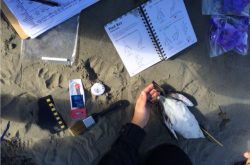
The common murre is a self-sufficient, resilient bird.
Though the seabird must eat about half of its body weight in prey each day, common murres are experts at catching the small “forage fish” they need to survive. Herring, sardines, anchovies and even juvenile salmon are no match for a hungry murre.
So when nearly one million common murres died at sea and washed ashore from California to Alaska in 2015 and 2016, it was unprecedented — both for murres, and across all bird species worldwide. Scientists from the University of Washington, the U.S. Geological Survey and others blame an unexpected squeeze on the ecosystem’s food supply, brought on by a severe and long-lasting marine heat wave known as “the blob.”
Their findings were published Jan. 15 in the journal PLOS ONE.
“Think of it as a run on the grocery stores at the same time that the delivery trucks to the stores stopped coming so often,” explained second author Julia Parrish, a UW professor in the School of Aquatic and Fishery Sciences. “We believe that the smoking gun for common murres — beyond the marine heat wave itself — was an ecosystem squeeze: fewer forage fish and smaller prey in general, at the same time that competition from big fish predators like walleye, pollock and Pacific cod greatly increased.”
Read more at UW News »
